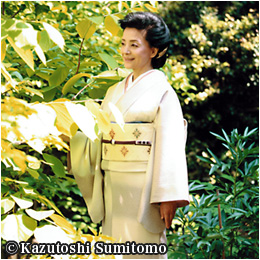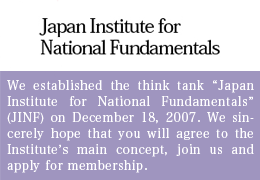Don’t Mistake the Intentions of the People’s Liberation Army vis-à-vis the Senkaku Islands
Prime Minister Yoshihiko Noda delivered quite a powerful address before personnel of the Japan Maritime Self Defense Force (JMSDF) during a fleet review held on October 14 at Sagami Bay, south of Tokyo. Describing the seas around the Japanese archipelago as the “very foundation” of this nation and “our biggest frontier,” Noda stated that “the security environment has become more difficult than ever before.” He then urged the assembled sailors to put in “more strenuous efforts and hard work” to safeguard Japan’s security and sovereignty.
Frankly speaking, however, it is the Noda administration, rather than the JMSDF, that should put in “more strenuous efforts and hard work” most. A quick read of journalist Satoru Tomisaka’s book, Behind the Scenes of China’s People’s Liberation Army (Bungei Shunju Ltd., Tokyo; scheduled for publication this month) (hereafter, Behind the Scenes) clearly shows how meticulously the Chinese government has been strengthening the PLA’s military capability across the board – its land, sea, air, space, and cyber forces – over the years. In marked contrast, however, the Japanese government has been extremely ill prepared – even for the immediate consequences of its decision to go ahead with the September 11 nationalization of the Senkaku Islands in the East China Sea.
Coupled with If Japan and China Clash (Bungei Shunju Ltd., Tokyo; 2011), a compilation of discussions among four specialists – an American, a Chinese, Tomisaka, and another Japanese – Behind the Scenes brings into focus how serious and impending the problems are that the Japanese government currently faces in connection with the latest dispute with China over the Senkakus.
According to Tomisaka, the PLA last summer made to the Chinese Communist Party (CCP) certain recommendations on the basis of Japan’s readiness to nationalize the Senkakus “similar to those made two years ago.” The original recommendations were made in September 2010 by the Second Department of the PLA’s General Staff Office charged with external intelligence in the wake of an incident in which a Japan Coast Guard patrol vessel was rammed by a Chinese fishing boat after it violated Japanese territorial waters around the Senkakus.
The “recommendations” quoted in detail in Behind the Scenes sternly conclude that “China must temporarily suspend its friendly policy (vis-à-vis Japan),” demanding that China not only impose economic and social sanctions but also take military actions, calling for the Chinese governments to:
– implement a land-sea-air maneuver in the East China Sea on a grand scale;
– deploy large (more than 1,000 tons) “Yuzheng” Fisheries Department patrol boats and “Haijian” State Oceanic Administration patrol boats in the seas around the Senkakus, accompanied by Chinese naval vessels; and,
– land marines along with special forces on the Senkakus, declare Chinese sovereignty over the islands, erect monuments testifying to China’s sovereignty, and withdraw as expeditiously as possible.
The PLA’s “Ambiguity”
However, the same recommendations, emphasizing a need for the PLA to prepare itself for a possible armed conflict with Japan over the Senkakus, were made to the Chinese government anew in September immediately after Japan announced its nationalization of the Sankakus. But the resolve of the PLA to “go all the way” obviously was let go “because of some political judgment on the part of the top echelon of the CCP,” according to Tomisaka.
However, as of this writing (October 17), seven warships from the PLA Navy’s North Sea Fleet, including destroyers, are spotted some 49 kilometers (approximately 30 miles) south-southeast of Yonaguni Island in the Sakishima island chain in Okinawa Prefecture. There were later reports that the fleet moved north towards the East China Sea from the Pacific Ocean and the contiguous area just outside Japanese territorial waters, later slipping back into Chinese waters after crossing the Japanese-Chinese median line about 80 kilometers (50 miles) southwest of Uwotsurijima Island, the largest of the Senkakus.
That as many as seven PLA Navy vessels cruised through the contiguous area of our waters should realistically be recognized as a clear indication that the PLA’s will impacted Chinese political behavior one way or another. Japan-China relations are at an extremely delicate and grave stage, which calls for Japan to go all out to prepare itself for an emergency in the worst case scenario.
Particularly worrisome under such circumstances is the credibility of China’s civilian control of its military. Would it be realistic to assume that the PLA will be expected to fully honor the CCP’s “political judgment”? Frankly, I consider it highly questionable whether the Chinese government can be expected to maintain civilian control over the PLA over these critical issues concerning the Senkaku Islands, the East China Sea, and the South China Sea.
Michael Green, the Japan Chair at the Center for Strategic and International Studies (CSIS), makes intriguing remarks in If Japan and China Clash pertaining to the Hainan Island incident of 2001, in which a US Navy EP-3E Aries II intelligence aircraft was forced to make an emergency landing on Hainan after a mid-air collision with a PLA interceptor fighter jet. Green, who then served the National Security Council (NSC) as director of Asian affairs with responsibilities for Japan, Korea, and Australia/New Zeland, is quoted as recalling that President Bush tried to call Jiang Zeming as many as nine times in an effort to establish communication with the Chinese head of state but that the latter steadfastly refused to answer the phone. Meanwhile, both the American ambassador to Beijing and the Commander of the US Pacific Fleet each tried desperately to contact their Chinese counterparts to no avail, as communication between Washington and Beijing was completely severed for a period of time. In point of fact, there was a precarious international security void that could have led to devastating consequences if push came to shove.
Ten years later today, how well are crisis avoidance mechanisms working between the US and China? Green says they are not working at all, because, as he interprets it, the Chinese government does not want the mechanisms to function properly; besides, the PLA prefers to leave a certain type of “ambiguity” in this regard.
China has long failed to answer questions from the international community about its aggressive military build-up, including its ambitious aircraft construction scheme. In order to justify its lack of explanation, China claims: “In a relationship between a strong country and a weaker country, increasing transparency is more disavantageous to the latter, forcing it to suffer further losses.” In other words, China claims to be weaker than the US and, therefore, is not obligated to explain anything. This is the Chinese “ambiguity” that Green refers to.
Military Organ Known as the Second Artillery Corps
Tomisaka points out the limits of China’s civilian control from another viewpoint, explaining: the top CCP echelon (i.e, the nine members of the Standing Committee of the CCP Politburo) has only two members, namely President Hu Jintao and Vice President Xi Jinping, who have contacts with the PLA leadership – a result from Mao Zetung’s decision to clearly separate politics and the military as a ploy to prevent the military from getting involved in intra-party power struggles. Tomisaka explains that Mao’s decision had the advantage of keeping the military at a distance from intra-party politics, but that it had the disadvantage of thinning the linkage between the CCP and the PLA. Tomisaka remarks:
“The PLA is a 2 million-plus armed forces made up of the army (1.6 million strong), the navy (260,000), and the air force (330,000); it is an extremely tall order for a top leader or two from the civilian sector ― like Hu and Xi ― to be expected to come to grips with its organization.”
While I wish to leave it to Behind the Scenes to explain how the PLA’s decision-making mechanism works, I must point out that Japanese politicians, from Prime Minister Noda down, should now particularly pay attention to the full scope of the PLA’s preparedness in all aspects, including its equipment and personnel. Especially noteworthy is the Second Artillery Corps (SAC), which constitutes China’s formidable strategic missile forces, including nuclear. Commanded directly by the Chinese Central Military Commission (CMC), SAC maintains more than 20 missile brigades and eight missile bases across China, with a total force of over 158,000 strong, including technicians, which is more than the total strength of the Japan Ground Self Defense Force.
Like SAC, the PLA Air Force’s 15th Airborne Corps is a special elite unit that comes under direct CMC command. It is 35,000 strong, and stands in the vanguard of high-tech warfare, equipped with every conceivable advanced equipment. Its cadre is made up of 400 rigidly selected top officers, some 60% of them university graduates, all of whom go through rigorous military training. The corps is truly an elite outfit in China, where only 35% of young people advance to colleges and universities.
China also is waging a vigorous national campaign involving all branches of the military, research institutions, think tanks, universities, and private corporations with the aim of nurturing human resources to prepare them for future cyber and space warfare.
In order to cope effectively with a Chinese threat of this magnitude, it is Prime Minister Noda and his cabinet ministers who must first and foremost put in “more strenuous efforts and hard work” than ever. In concrete terms, this means exercising strong political leadership to substantially increase next year’s defense budget rather than buckling under pressure from bureaucracy.
(Translated from “Renaissance Japan” column no. 531 in the October 25, 2012 issue of The Weekly Shincho)








